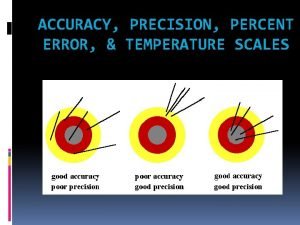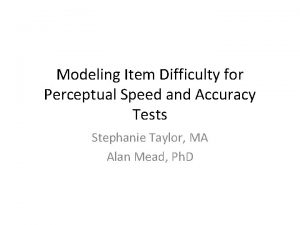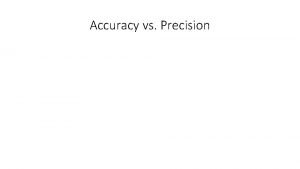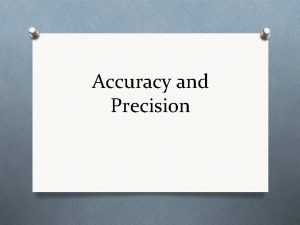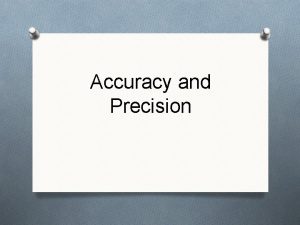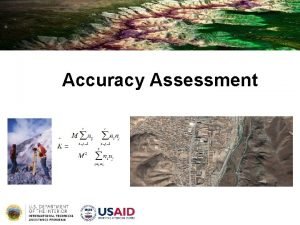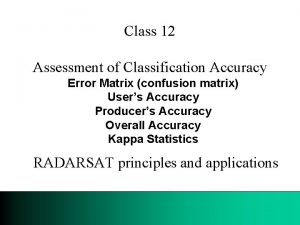Accuracy Assessment The Error Matrix l Error matrix













- Slides: 13

Accuracy Assessment

The Error Matrix l Error matrix for a 5 -classification Reference Map Class No. Pixels Classified as No. Pixels Crops Forest Wetland Water Urban Crops 120 100 9 3 -- 8 Forest 150 15 105 7 3 20 Wetland 80 5 6 60 5 4 Water 90 -- 1 2 84 3 Urban 60 1 2 1 1 55 Total 500 121 123 73 93 90 Overall Accuracy = (100 + 105 + 60 + 84 + 55) / 500 = 404 / 500 = 81%

The Error Matrix l The starting point for a series of descriptive and statistical techniques to evaluate accuracy n n n n An N x N matrix where N = number of classes Compares classified (or interpreted) data to reference data classes Row totals = number of pixels in the reference data Column totals = number of pixels assigned to each class Diagonal elements show agreement between reference data and the classification (i. e. , correct classification) Rows include errors of omission Columns include errors of commission

Terminology l Type I error (applying the wrong label) n n l False positive Commission error Reduced user’s accuracy Reduced “Precision” Type II error (failing to apply the correct label) n n False negative Omission error Reduced producer’s accuracy Reduced “Recall”

Commission and Omission Errors

Producer’s and User’s Accuracies User’s accuracy considers commission errors Producer’s accuracy considers omission errors

Kappa Statistic l l Over the past 15 years the Kappa statistic has become a standard part of evaluating classification accuracy n Based on agreement between the classification and reference data (the diagonal) and chance agreement (the row and column totals or marginals) In other words, Kappa is a measure of agreement adjusted for chance agreement Kappa = Observed Accuracy - Expected Accuracy 1 – Expected Accuracy

Calculation of Expected Agreement by Chance Row Marginals Column Marginals Products of Row x Column Marginals

Calculation of Kappa l “Observed” correct = the overall accuracy = 404 / 500 = 0. 81 l Expected agreement by chance = sum of diagonal / grand total = 52, 580 / 250, 000 = 0. 21 l Kappa Statistic = Observed - Expected / 1 - Expected = (0. 81 - 0. 21) / (1 - 0. 21) = 0. 69 / 0. 79 = 0. 76 = 76% better than chance agreement

Kappa Summary l Although it is now commonly used, newer thinking suggests that adjusting for chance agreement is unnecessary for evaluating accuracy n The map is the map and each pixel is either correctly or incorrectly classified u In reality there is no way to know which pixels were correctly classified by chance (as opposed to “skill”) n In other words, Kappa may be more a theoretical measure than a practical one.

Landsat Classification of Twin Cities Metro Area Land Cover Cultivated Forest Shrub & Herbaceous Water Urban – % Impervious 0 100 Now, how accurate is this classification? Miles 0 4. 5 9 18 27 36

Error Matrix and Classification Accuracy for Landsat Classification of Twin Cities Metro Area No. Pixels Classified as Total Prod. Acc. (%) 2 1303 95. 9 0 0 1760 97. 6 496 0 1 507 97. 8 77 33 522 5 640 81. 6 0 0 1 0 263 264 99. 6 Total 1279 1847 555 522 271 4474 User Acc. (%) 97. 7 93. 0 89. 4 100. 0 97. 0 Ref. Class Urban Cult. Forest Urban 1250 46 5 0 Cult. 23 1717 20 Forest 3 7 Shrub & Herb. 3 Water l l Overall accuracy = 94. 9% Kappa statistic = 93 Shrub & Water Herb. 94. 9

Concluding Thoughts…. l l Accuracy assessment is critical to inventory, mapping and monitoring projects n No project should be considered complete without an evaluation of its accuracy n The same techniques can be applied equally well to aerial photography and photo interpretation Must be well planned and statistically valid Should be reported as an error matrix and associated statistics It’s expensive -- so budget for it
 Equation for temperature
Equation for temperature Perceptual speed and accuracy test
Perceptual speed and accuracy test Hát kết hợp bộ gõ cơ thể
Hát kết hợp bộ gõ cơ thể Ng-html
Ng-html Bổ thể
Bổ thể Tỉ lệ cơ thể trẻ em
Tỉ lệ cơ thể trẻ em Gấu đi như thế nào
Gấu đi như thế nào Glasgow thang điểm
Glasgow thang điểm Bài hát chúa yêu trần thế alleluia
Bài hát chúa yêu trần thế alleluia Các môn thể thao bắt đầu bằng tiếng đua
Các môn thể thao bắt đầu bằng tiếng đua Thế nào là hệ số cao nhất
Thế nào là hệ số cao nhất Các châu lục và đại dương trên thế giới
Các châu lục và đại dương trên thế giới Công thức tính độ biến thiên đông lượng
Công thức tính độ biến thiên đông lượng Trời xanh đây là của chúng ta thể thơ
Trời xanh đây là của chúng ta thể thơ
